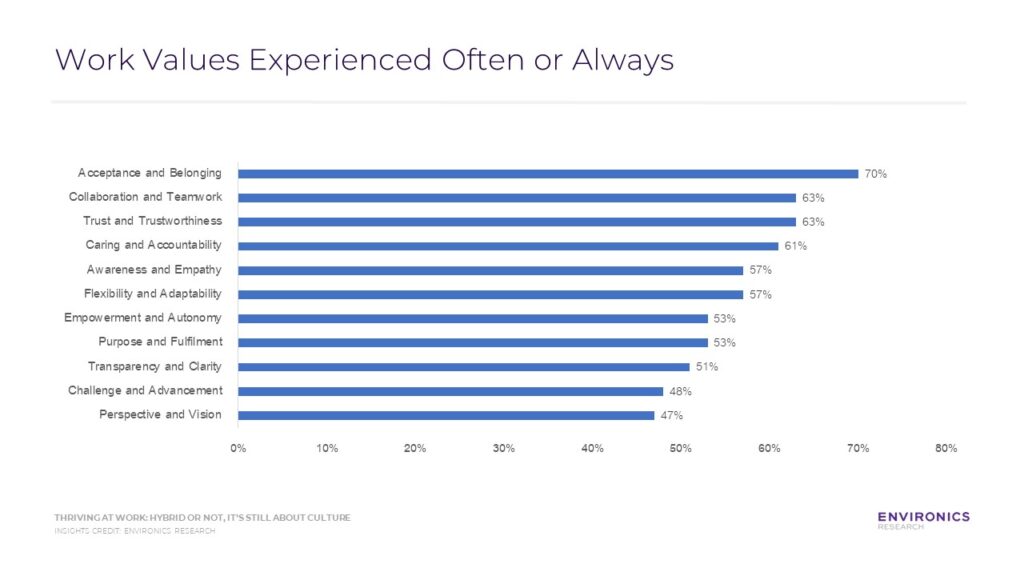In my last post, I reported an interesting pattern among working Canadians, discovered as part of Environics’ foundational 2023 study of workplace values and culture. In an increasingly hybrid working world: We found that Canadians were most likely to thrive at work when they worked “from work” one to three days per week.
Those who put in a traditional five-day week on-site at their workplaces were least likely to be thriving. (See that previous post for more on our sample and the empirical definition of our workplace thriving index called, “Work Thrive”). These findings seem to add to the accumulating evidence that the traditional “five-day grind” needs a rethink.
Why do people appear not to thrive when they spend the full week at their workplace? Our data may point to some reasons – particularly when we consider factors that are related to, and perhaps even actively drive, thriving at work when people spend fewer than five days on site. Simply put, some of the drivers of thriving may not require a full five work-from-work days in order to have a positive impact on people’s experiences of work. And perhaps too much exposure to others may be detrimental. Why? Let’s start by considering the foundations and origins of workplace values and culture as one possible precursor to thriving.
Where Do Positive Workplace Culture Experiences Come From?
We know that an organization’s leaders inculcate its culture and values through the design of formal processes, procedures and incentives for “how we do things around here.” However, culture is also transmitted through less formal means, for example by the expectations and norms communicated to and among employees and modeled by leaders (for example, the “real” incentive structure that operates outside of that formally approved and espoused). In short, cultures can be intentionally managed or they can emerge organically; they can be conveyed through systems or informed by human interactions.
It stands to reason that to create positive, values-based work experiences—the kind of experiences possibly associated with thriving—some work values may require more WFW (work from work) time to manifest and nurture than others. Why? Because some of them require exposure to the less formal values, norms and behaviours that people tend to encounter only when working with others at the workplace itself. Other values that are more “organizational” and “systemic” in tone, meanwhile, may be successfully communicated more formally. These may be easier to signal or instill without as much workplace attendance.
Now, different kinds of organizations are constrained by different potentials for the number of work-from-home days per week they can offer from an efficacy/productivity perspective; many organizations simply cannot operate with fewer that all hands on deck at work. For those that can offer hybrid arrangements, some will choose to offer more WFH work opportunity as a conscious expression of their culture. Unfortunately, our data did not delve into these structural aspects of an employee’s work situation, nor did we query employees’ preferences about working from home. But at a higher, normative level, across all manner of employment occupations and situations, we think our results can answer a key question, “What drives workplace thriving?”
Driving Work Thrive
In addition to asking survey respondents how many days per week they typically worked from work, we asked about other possible drivers of thriving, such as about their level of seniority, about what they thought was important at and about work (their “work values”) and about how often they actually experience those same values at their places of employment.
Some of our findings were expected, such as the fact that job seniority is correlated with Work Thrive. This makes sense, given the greater levels of personal agency afforded by “big” jobs — though it is notable that the relation was less strong than we expected. More surprisingly, perhaps, we found that thriving was not generally related to specific types of occupation or specific job functions. People can thrive in many roles, in many sectors.
However, as alluded above, the most important class of drivers of thriving identified in our empirical analysis was the experience of living out workplace values. In a linear regression analysis, nearly half of the variance in self-reported workplace thriving among full-time workers is accounted for by the work values they regularly perceive and experience in their workplaces. Workplace values and culture appear to have significant impact on whether employees thrive because it is reasonable to suppose that people who frequently experience workplace norms and values that matter to them, such as “Empowerment and Autonomy” and “Acceptance and Belonging,” will be more likely to thrive at work in a culture they desire and enjoy.
Our regression of the Work Thrive index on 11 values experienced at work revealed that the top five key drivers of thriving were (in order of importance):
- Purpose and Fulfilment
- Collaboration and Teamwork
- Transparency and Clarity
- Empowerment and Autonomy
- Trust and Trustworthiness
Now that we have determined what values-based experiences most drive employees to thrive we can ask the next logical question, “How well are Canadian organizations doing now in creating the values-based experiences that support a thriving workforce?”
Do Canadian Organizations Currently Promote Employee Thriving Through Values and Culture?
The chart below shows how often employees report experiencing the 11 key workplace values we measured in our study, each of which was rated overall as important to experience at work by employees. (While we don’t define these work values in detail here, as we did for our survey respondents, they’re mainly self-evident in common language). To measure frequency of the experiences, we used a five-point scale that ranged from ‘not at all’ to ‘always.’
The answers we received seem mixed. They suggest that organizations are doing reasonably well in creating experiences of positive workplace values on many of the dimensions that employees value. About half or slightly more than half of employees report experiencing these values often or always. Of particular note are the high levels of Acceptance and Belonging people report, experiences of certain benefit to employees in a time of societal fracturing and isolation.

But there is certainly room for improvement. For example, least experienced are indications of organizations’ Perspective and Vision, an aspect of their Mission, Vision and Values that should not be difficult to provide with straightforward communication from leaders. Other values vary in how frequently they are “landing” with employees.
How are organizations doing in terms of their performance delivering experiences for the top five key drivers of thriving? Well, not badly in some cases (relative to the other values measured), for example, for Collaboration and Teamwork and Trust and Trustworthiness (see graph). But certainly, improvements can be made to consciously boost culture in value areas such as Transparency and Clarity and Empowerment and Autonomy, where organizations perform less well.
Most importantly, and replicating many other organizational studies, we found that the most powerful driver of thriving at work (more than twice as important as any other experience), namely having employment filled with the higher Maslovian “Being” need of Purpose and Fulfilment, was underserved. Now, it is true that not all forms of employment offer equal opportunity to meet such self-actualizing needs for purpose, meaning and fulfilment. But all employers should be thinking about both the intrinsic nature of the work they provide (what and how employees do it), their own organizational purpose and mission in doing such work (why the organization does it – and indeed, may exist just to do it), and the culture they can operationalize to create opportunity for meaningful work experiences for their employees. Of course, part of the secret in creating meaningful, purposive work seems to lie in the fact of people’s basic sociality and their need to affiliate with others when working toward “common cause” in accepting, collaborative teams.
Still, creating purposeful work may be easier said than done. It may be harder still in newly “hybridized” workplaces. Or is it? Previously, I mentioned that some values we studied may require more WFW days to experience than others. What is the WFW/WFH balance that best promotes experiences of Purpose and Fulfilment – the value most associated with workplace thriving? Can this be accomplished in just two or three WFW days in the workplace?
In my next post I’ll consider these questions. I’ll also reflect on other specific thriving-related values – and how many WFW days per week employees seem to need in order to experience them.





